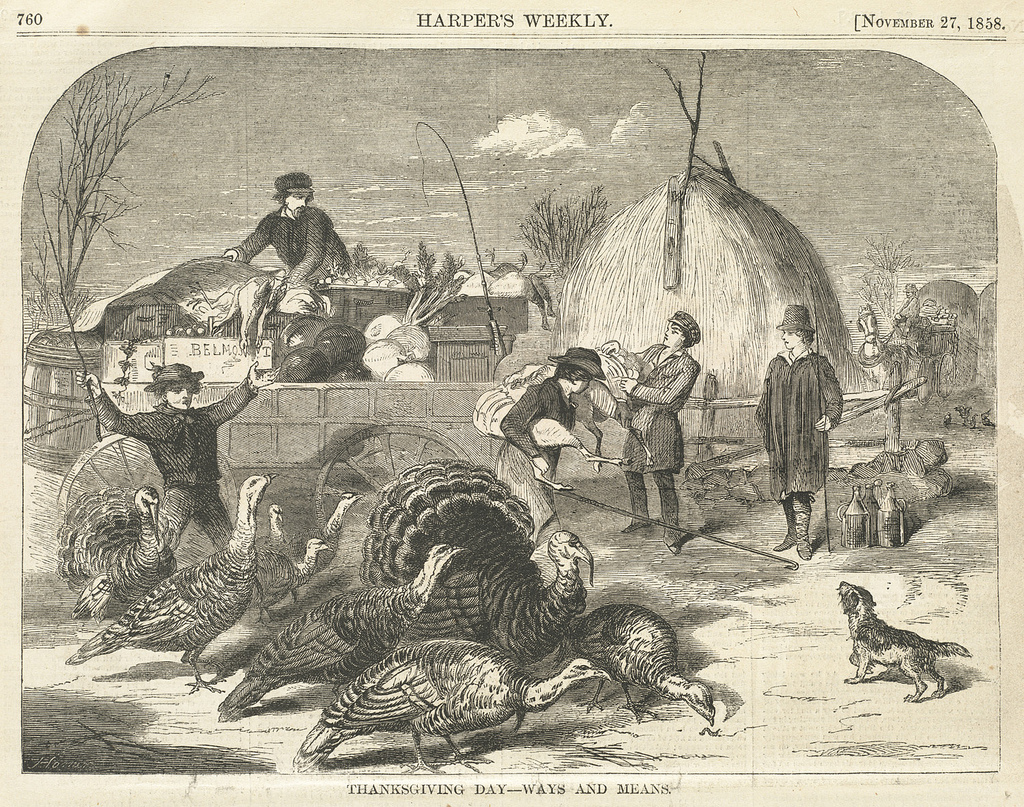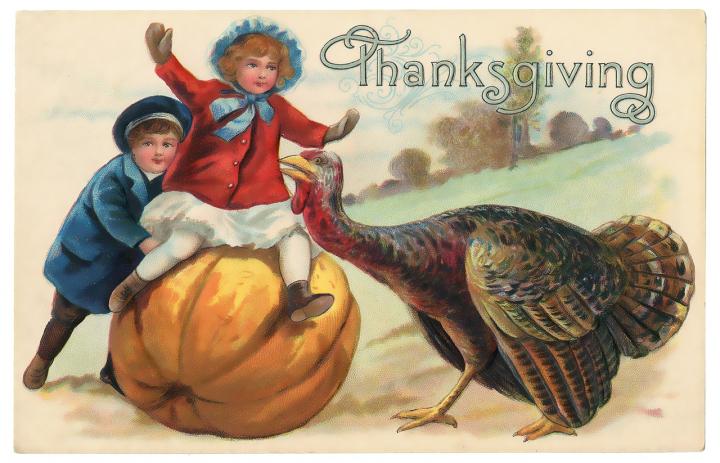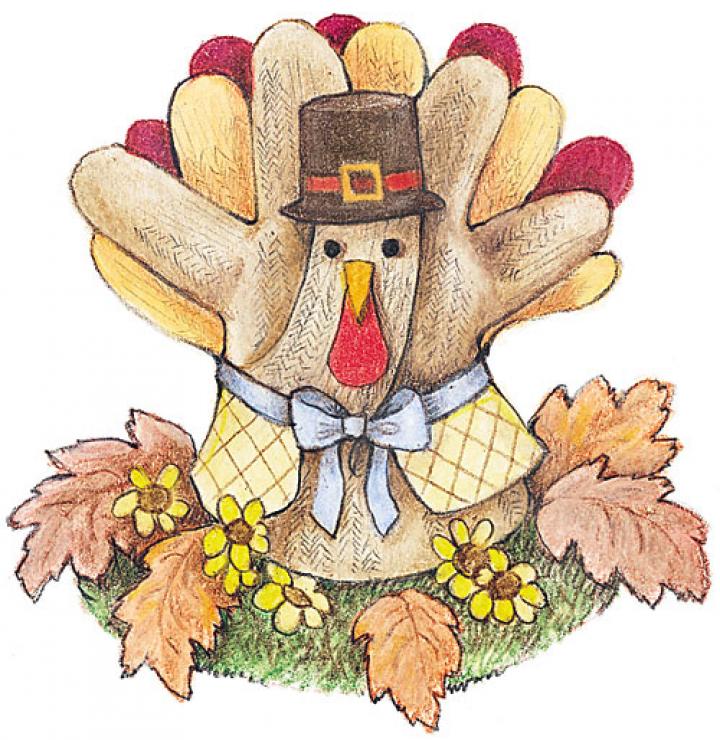THANKSGIVING DAY 2019
WHY IS THANKSGIVING SO LATE THIS YEAR?
WHY IS THANKSGIVING SO LATE THIS YEAR?

In the United States, Thanksgiving is celebrated on the fourth Thursday in November—this year, on November 28! Why is Thanksgiving so late this year? Why do we celebrate this all-important feast day? Enjoy a brief history of the holiday, Thanksgiving trivia, folklore, and more!
WHEN IS THANKSGIVING? | THANKSGIVING DATES
Thanksgiving in the United States is always celebrated on the fourth Thursday in November. In Canada, Thanksgiving is celebrated on the second Monday in October (read more about Canadian Thanksgiving).
| Year | U.S. Thanksgiving | Canadian Thanksgiving |
|---|---|---|
| 2019 | Thursday, November 28 | Monday, October 14 |
| 2020 | Thursday, November 26 | Monday, October 12 |
| 2021 | Thursday, November 25 | Monday, October 11 |
| 2022 | Thursday, November 24 | Monday, October 10 |
WHY IS THANKSGIVING SO LATE THIS YEAR?
Does Thanksgiving feel a little later than usual this year? You’d be right! We’re certainly noticing more than the usual overlap with Christmas decorations.
Thanksgiving occurs on November 28 in 2019, which is, in fact, the latest date that it can possibly occur on. The last time Thanksgiving landed on the 28th was in 2013, and before that, in 2002.
Since 1941, Thanksgiving has been held on the fourth Thursday in November, which means that the actual date of the holiday shifts each year. The earliest date that Thanksgiving can occur on is November 22; the latest, November 28.
What’s interesting is that President Franklin Roosevelt decided to move Thanksgiving from the fourth Thursday in November to the third Thursday in November back in 1938. However, this was not a popular move. (Read more about this story below.)
WHAT IS THE TRUE MEANING OF THANKSGIVING?
Prior to the formal establishment of Thanksgiving, Native American harvest festivals had been celebrated for centuries, with colonial services dating back to the late 16th century. The autumnal feasts celebrated the harvest of crops after a season of bountiful growth.
In the early 1600s, communities of settlers in both Massachusetts and Virginia came together to give thanks for their survival, for the fertility of their fields, and for their faith. The most widely known early Thanksgiving is that of the Pilgrims in Plimoth, Massachusetts, who feasted for three days with the Wampanoag people in 1621.
Today, folks celebrate Thanksgiving for a multitude of reasons. For some, it remains a way to express gratitude for the harvest or to a higher power; for others, it’s a holiday built upon being with family and simply enjoying delicious food.
HISTORY OF THANKSGIVING IN THE UNITED STATES
The first national holiday of Thanksgiving was observed for a slightly different reason than celebration of the harvest—it was in honor of the creation of the new United States Constitution! In 1789, President George Washington issued a proclamation designating November 26 of that year as a “Day of Publick Thanksgivin” to recognize the role of providence in creating the new United States and the new federal Constitution.
Washington was in his first term as president, and a young nation had just emerged successfully from the Revolution. Washington called on the people of the United States to acknowledge God for affording them “an opportunity peaceably to establish a form of government for their safety and happiness.” This was the first time Thanksgiving was celebrated under the new Constitution.
Thanksgiving Becomes a Federal Holiday
While Thanksgiving became a yearly tradition in many communities—celebrated on different months and days that suited them—it was not yet a federal government holiday. Thomas Jefferson and many subsequent presidents felt that a public religious demonstration of piety was not appropriate for a government type of holiday in a country based in part on the separation of church and state. While religious thanksgiving services continued, there were no further presidential proclamations marking Thanksgiving until the Civil War of the 1860s.

A depiction of Thanksgiving in 1858, by Winslow Homer. Image courtesy of the Boston Public Library.
Thanksgiving is oberved the last Thursday in November
In 1863, President Lincoln made a proclamation marking Thursday, November 26, 1863, as Thanksgiving. Lincoln’s proclamation harkened back to Washington’s, as he was also giving thanks to God following a bloody military confrontation. In this case, Lincoln was expressing gratitude to God and thanks to the Army for emerging successfully from the Battle of Gettysburg. He enumerated the blessings of the American people and called upon his countrymen to “set apart and observe the last Thursday of November next, as a day of Thanksgiving and Praise.” As of that year, Thanksgiving was celebrated on the last Thursday in November.
Thanksgiving is briefly moved to the third Thursday in November
In 1939, President Franklin D. Roosevelt changed Thanksgiving from the last Thursday in November to the second-to-last Thursday. It was the tail-end of the Depression, and Roosevelt’s goal was to create more shopping days before Christmas and to give the economy a boost. However, many people continued to celebrate Thanksgiving on the last Thursday in November, unhappy that the holiday’s date had been meddled with. You could argue, however, that this helped create the shopping craze known as Black Friday.
In 1941, to end any confusion, the president and Congress established Thanksgiving as a United States federal holiday to be celebrated on the fourth Thursday in November, which is how it stands today!
Of course, Thanksgiving was not born of presidential proclamations. Read about Sarah Josepha Hale, the “Godmother of Thanksgiving” who helped turn this historic feast into a national holiday.
HOW IS THANKSGIVING DIFFERENT IN CANADA?
Thanksgiving Day in Canada is celebrated on the second Monday in October and has different origins than the American version of the holiday. The first Thanksgiving meal observed in what is now Canada occurred in 1578, when English explorer Martin Frobisher and his crew held a meal to thank God for granting them safe passage through the wilds of the New World.
Canadians get that Monday off of work in most parts of the country, but in Atlantic Canada (Prince Edward Island, New Brunswick, Nova Scotia, and Newfoundland and Labrador), it’s an optional holiday. Many Quebecers don’t celebrate the holiday at all.
Today, Canadians often visit with family and friends to celebrate. The Thanksgiving food traditions tend to be pretty similar to their American neighbors: turkey, stuffing, potatoes, and cranberry sauce are traditional. Add some maple syrup for a uniquely Canadian twist! See some Maple Syrup recipes.
Canadian football is on the television, and many Canadians get outside for a nice hike or ramble in the woods, since the weather has not yet taken a turn for the worse. Everyone is thankful for the harvest!
Read more about the differences between Canadian and American Thanksgiving.

WHY IS THANKSGIVING CELEBRATED WITH TURKEY?
Turkey has become the traditional Thanksgiving fare, but did you know that it was at one time a rare treat? During the 1830s, an eight- to ten-pound bird cost a day’s wages!
Even though turkeys are much more affordable today, they still remain a celebratory symbol of bounty. In fact, astronauts Neil Armstrong and Edwin Aldrin ate roast turkey in foil packets for their first meal on the Moon.
See all of our Thanksgiving trivia and fun facts!
- Turkey Trivia
- The Great Yam Scam
- Cranberry Trivia
- Historic Thanksgiving Storms
- Why Do We Eat Turkey at Thanksgiving?
- Why We Can Feel Good Eating Thanksgiving Food?
THANKSGIVING WEATHER FOLKLORE
- Turkeys perched on trees and refusing to descend indicates snow.
- If the first snow sticks to the trees, it foretells a bountiful harvest in the coming year.
- If sheep feed facing downhill, watch for a snowstorm.
- Thunder in November indicates a fertile year to come.
- If there be ice in November that will bear a duck, there will be nothing thereafter but sleet and muck.
- As November 21st, so the winter.
- When the winter is early, it will not be late.
The term “Indian summer” refers to a period of warm weather occurring between November 11 and 20. Read more about Indian summers.
THANKSGIVING POEMS AND QUOTES
Perhaps these poems and quotes will come in handy for your Thanksgiving card!
Over the river and through the wood—
Now grandmother’s cap I spy!
Hurrah for the fun!
Is the pudding done?
Hurrah for the pumpkin-pie!
–Lydia Maria Child
Now grandmother’s cap I spy!
Hurrah for the fun!
Is the pudding done?
Hurrah for the pumpkin-pie!
–Lydia Maria Child
Orchards have shared their treasures,
The fields, their yellow grain,
So open wide the doorway–
Thanksgiving comes again!
–Unknown
The fields, their yellow grain,
So open wide the doorway–
Thanksgiving comes again!
–Unknown
Ah! On Thanksgiving Day, when from East and from West,
From North and from South, come the pilgrim and guest,
What moistens the lip, and what brightens the eye?
What calls back the past like the rich pumpkin pie?
–J. G. Whittier
From North and from South, come the pilgrim and guest,
What moistens the lip, and what brightens the eye?
What calls back the past like the rich pumpkin pie?
–J. G. Whittier
“An optimist is a person who starts a new diet on Thanksgiving Day.” –Irv Kupcinet, American columnist (1912–2003)
“Radical historians now tell the story of Thanksgiving from the point of view of the turkey.” –Mason Cooley, U.S. aphorist

THANKSGIVING CRAFTS FOR KIDS & ADULTS
Perfect for kids and great for decorating the home, these holiday crafts are easy and fun!
THANKSGIVING RECIPES: DINNER, SIDES, DESSERTS, AND MORE
Is it your turn to prepare the Thanksgiving meal? Here are a few of our favorite Thanksgiving recipes to give you some inspiration:
- Classic Thanksgiving Recipes—including some historically-inspired dishes.
- Thanksgiving Side Dishes—our favorite sides to accompany that turkey!
- Make-Ahead Thanksgiving Recipes—to save you some time on the day-of!
- How to Cook a Turkey—the basics of cooking the perfect Thanksgiving turkey.
- Thanksgiving Dessert Recipes—absolutely mouthwatering.
- Thanksgiving Leftovers—because the leftovers are the best part!
HAVE A HAPPY THANKSGIVING!
We give thanks to you, our Almanac community, and wish you a Thanksgiving feast that is both filling and full of grace this year!
What Thanksgiving traditions do you follow in your family? Let us know in the comments!
SOURCE:
The Old Farmer's Almanac

Comentarii
Trimiteți un comentariu